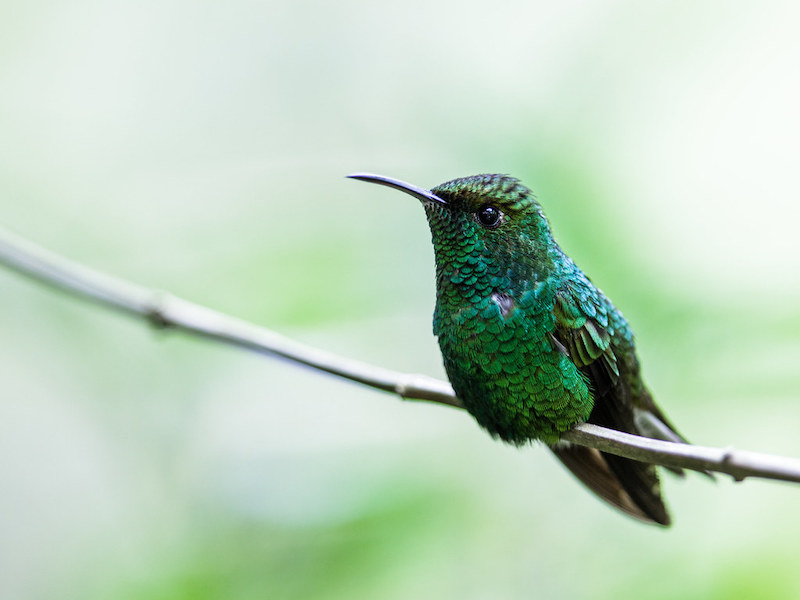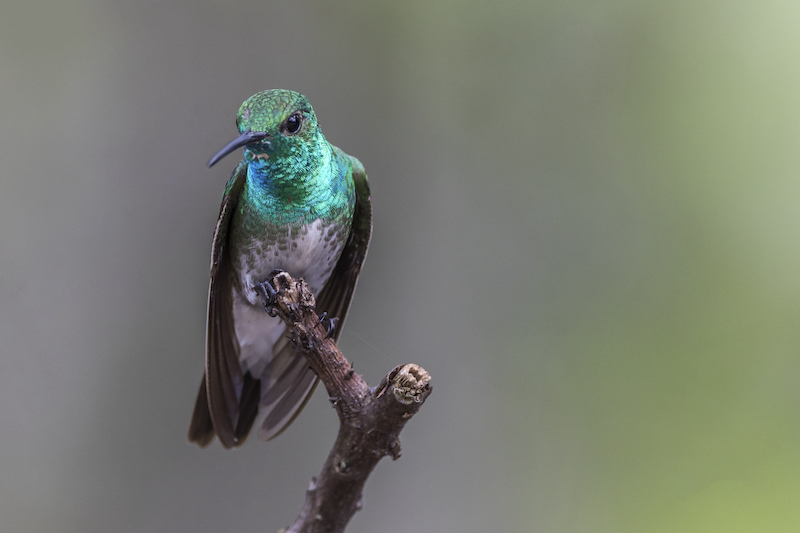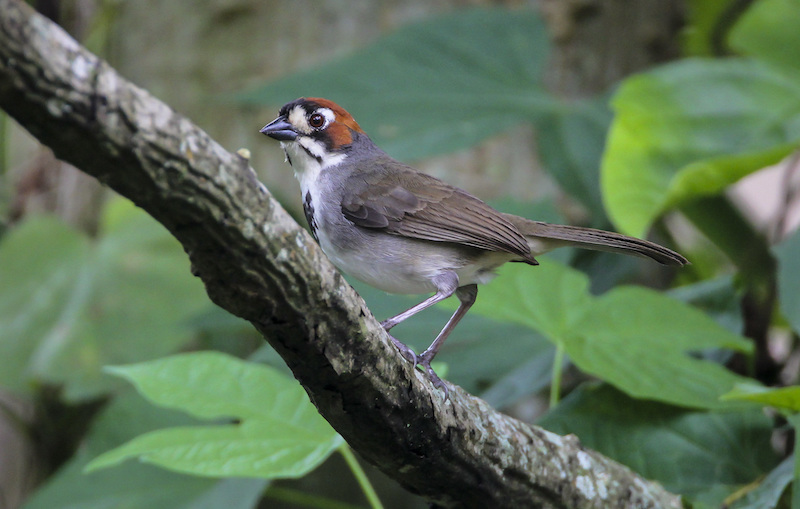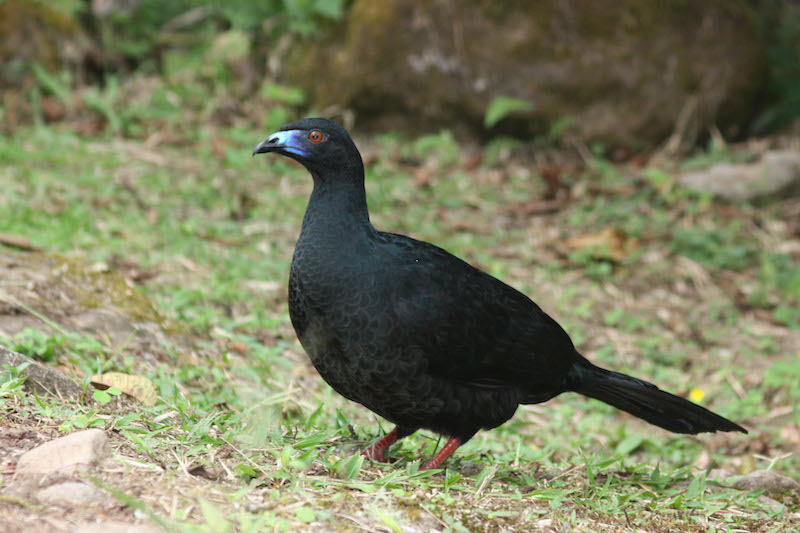5 Endemic bird species from Costa Rica
All in all, fully 11% of Costa Rica’s avifauna is restricted to very limited ranges within the southern half of the Central American isthmus, which is an exceptionally high rate of endemism, even for the neotropics.
Coppery-headed emerald (Microchera cupreiceps)

This is a small hummingbird in the «emeralds», tribe Trochilini of the subfamily Trochilinae.
Description.
The coppery-headed emerald is about 7.5 cm (3.0 in) long and weighs about 3.0 to 3.3 g (0.11 to 0.12 oz). Both sexes have a moderately decurved bill whose mandible has a pinkish base. The adult male has a dull coppery bronze crown, a bronze-green nape, back, and rump, and bright coppery bronze upper-tail coverts. Its central pair of tail feathers are bronze, the next three pairs white with pale gray tips, and the outermost pair white with black tips. Its underparts are bright yellowish metallic green with white undertail coverts. Males in the far northern Cordillera de Guanacaste also have a purple spot in the center of the breast.
The adult female has metallic green upperparts with bright somewhat coppery bronze uppertail coverts. Its central pair of tail feathers are bright bronze, the next three pairs white with a gray or dusky bar near the end, and the outermost pair white with gray or dusky tips. Its underparts are dull white to grayish white that become white at the vent area; there are also metallic green spots along the flanks. The immature male is similar to the adult but duller and has black tips on all tail feathers except the central pair.
Distribution and habitat.
The coppery-headed emerald is found in the highlands of northern and central Costa Rica. In most of its range it is found on the Caribbean slope but in the far north is also found on the Pacific slope. It inhabits the edges and interior of moist to humid montane forests. In the forest interior males are often found in the canopy and females in the understory but both occur at all levels at the edges and in semi-open areas like clearings. In elevation, it ranges from 300 to 1,500 m (980 to 4,900 ft) on the Caribbean slope but on the Pacific side is seldom found below about 1,200 m (3,900 ft).
Feeding.
The coppery-headed emerald forages for nectar at a wide variety of flowering plants, shrubs, and trees; examples include those of genera Besleria, Cavendishia, Clusia, Guarea, Pithecellobium, Quararibea, Satyria, and Inga. In addition to nectar, it gleans small arthropods from foliage and captures them by hawking from a perch.
Breeding.
The coppery-headed emerald’s breeding season extends from October to March and may vary within that window from year to year. Males court females at leks in small groups, singing from a perch and chasing other males. Females construct a small cup nest of plant down and tree fern scales bound with spiderwebs with some moss and lichen on the outside. It is typically placed between 1 and 3 m (3 and 10 ft) above the ground in the understory or along an edge. The clutch size is two eggs; the incubation period and time to fledging are not known.
Mangrove hummingbird (Amazilia boucardi)

This is an Endangered species of hummingbird in the «emeralds», tribe Trochilini of the subfamily Trochilinae.
Description.
The mangrove hummingbird is 9.5 to 11 cm (3.7 to 4.3 in) long and weighs about 4.5 g (0.16 oz). Both sexes have a medium-length bill, slightly decurved, with a black maxilla and a reddish mandible with a dusky tip. Adult males have golden to bronze-green upperparts and flanks. Their chin, throat, and breast are glittering bluish-green with white bars near the end of the chin feathers. Their belly is whitish with bronze-green sides and their undertail coverts are white. The slightly forked tail is bronzy green; the outer feathers have blackish outer edges and tips. Adult females are similar to males but with less green on the underparts and grayish tips on the outermost tail feathers. Immature birds resemble adult females but are more grayish below.
Distribution and habitat.
The mangrove hummingbird is sedentary. It is found only on the Pacific coast of Costa Rica. It inhabits large stands of tea mangrove Pelliciera rhizophorae and sometimes adjacent terrestrial second growth. Its distribution is not continuous.
Feeding.
The mangrove hummingbird forages for nectar, primarily at mangrove flowers. It has also been observed feeding at Inga, Heliconia, and Maripa in a terrestrial forest clearing near mangroves. In addition to nectar, it feeds on insects.
Breeding.
The mangrove hummingbird’s breeding season spans from October to February. It builds a cup nest of balsa (Ochroma pyramidale) floss and other soft plant fibers bound with spiderwebs and with lichens on the outside. It is usually placed on a mangrove twig between 1 and 4 m (3 and 10 ft) above the water. The female incubates the clutch of two eggs, but the incubation period and time to fledging are not known.
Cabanis’ ground sparrow (Melozone cabanisi)

Cabanis’ ground sparrow or Costa Rican ground sparrow (Melozone cabanisi), is a New World sparrow. It previously was considered a subspecies of the Prevost’s ground sparrow.
Cabanis’ ground sparrow is endemic to central Costa Rica. It is ranked as «Near Threatened» by the IUCN due to its small range of habitat that has seen increased urban development in recent decades. The sparrow has a limited distribution area and the population is relatively small, estimated at only between 20,000 and 50,000 adult individuals. It is also believed to be decreasing in number.
Description.
It is on average 15 cm long and weighs 28 g. The adult has a stubby dark-grey bill, unstreaked olive-brown upperparts, a rufous crown, and mainly white underparts. Young birds are browner above, have yellower underparts, and a duller indistinct head pattern. The rufous of the crown extends to behind the eye and is bordered on its anterior edge with black. This black border is broken by a white eye-ring. The forehead is white, bordered below with a thin black line; there is a black malar stripe and a black central breast patch.
Distribution and habitat.
Restricted to the Central Valley of Costa Rica, mostly found and seen in Cartago, in fact, Paraiso has been named Cabani’s Sparrow City.
Black-cheeked ant tanager (Habia atrimaxillaris)

This is a species of bird in the family Cardinalidae
Description.
Based on a small number of specimens, the black-cheeked ant tanager is 18 to 19 cm (7.1 to 7.5 in) long and weighs 36.2 to 48.9 g (1.28 to 1.72 oz). The male’s upper parts are dark gray with a red tinge, and it has a (usually invisible) orange-red crest. The face has a diffuse black «mask». The throat is bright salmon orange that transitions through darker salmon to dark gray with a pink tinge on the belly. The female is similar but duller and its crest is smaller.
Feeding.
The black-cheeked ant tanager is primarily insectivorous, though it also eats fruits and small vertebrates.
Breeding.
The black-cheeked ant tanager has been documented nesting between January and March. It builds an open cup nest fairly low in understorey vegetation. All known clutches were of two eggs. The species appears to nest cooperatively, as three adults have been documented attending nestlings.
Black Guan ( Chamaepetes unicolor)

The black guan (Chamaepetes unicolor) is a species of bird in the chachalaca, guan, and curassow family Cracidae. It is endemic to Costa Rica and western Panama.
Description.
The black guan is 62 to 69 cm (2.03 to 2.26 ft) long and weighs about 1,135 g (2.502 lb). Adults have all-black plumage with contrasting bright blue facial skin around a red eye. Their legs and feet are pinkish-red. Juveniles are similar but less glossy and their underparts are browner and their facial skin is blackish or dark brown.
Distribution and habitat.
The black guan is found from the Cordillera de Guanacaste in northern Costa Rica to the western Coclé Province in Panama. It inhabits cloud forest in the Talamancan montane forest ecozone. It prefers steep terrain in the temperate, subtropical, and tropical zones, usually between about 1,000 and 2,250 m (3,280 and 7,380 ft) of elevation, but in some areas as low as 800 m (2,600 ft) and in others as high as 3,000 m (9,800 ft).
Feeding.
The black guan forages singly, in pairs, or in small groups. Its primary diet is fruits; studies in Costa Rica have identified at least 35 different species eaten. It mostly feeds in trees but will also eat fallen fruit on the ground.
Breeding.
The black guan’s breeding season is believed to span from February to June. The one described nest was a small platform of twigs and leaves placed in a clump of epiphytes in a tree 4.5 m (15 ft) above the ground. The clutch size is two or three eggs.
Reference: Endemic list by Richard Garrigues
